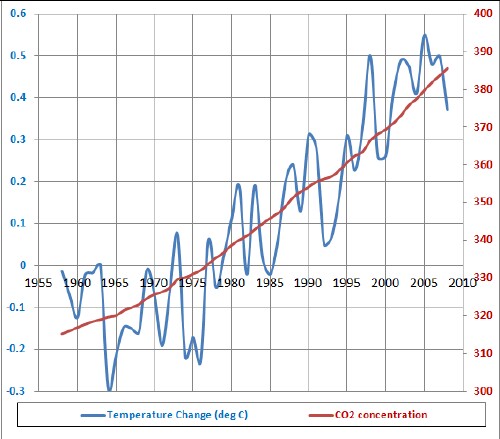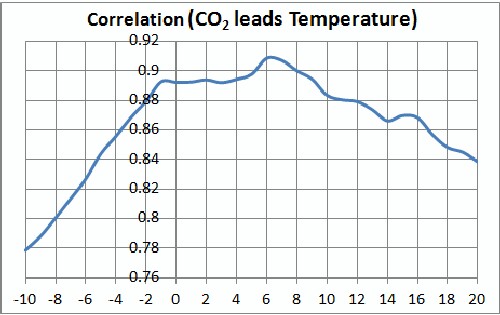
The temperature zero is the mean temperature from 1961-1990.
L. David Roper
http://arts.bev.net/RoperLDavid/
20 March, 2010
The claim is often made that CO2-atmospheric-concentration does not cause Earth-average-temperture change.
There seems to be a memory blocking of the fact that the Earth has a high-enough temperature for life because CO2 and other gases in the atmosphere trap heat and that laboratory experiments have shown that small CO2 concentrations trap heat by preventing infrared radiation from passing through.
The science of the mutual positive feedback between Earth average temperature and atmospheric-CO2 concentration is well established. Two variables that have mutual positive feedback lead or lag each other depending on which one is first changed by some third variable on which it is dependent. Anytime one of the two variables is changed by some third variable changing it will cause the 2nd variable to change in the same direction; then the second changing causes the first to further change in that direction. If no other variable intervenes to stop the positive feedback, a huge change in both variables can occur. This apparently is what is revealed in the 425,000 years of the Antarctica ice-core data. What is uncertain are the variables other than temperature and CO2 concentration that cause changes in temperature and CO2 concentration.
In this article I show that the recent CO2 concentration leads recent temperature. Even if it did not, it could not be read as a proof that dumping CO2 into the atmosphere does not change average Earth temperature, because other variables could be changing both temperature and CO2 concentration.
The Earth-average-temperature data and atmospheric-CO2-concentration data used are shown in the following graph:

The temperature zero is the mean temperature from 1961-1990.
The correlations for atmospheric-CO2 concentration leading Earth average temperature are shown in the following graph:

Note that the maximum correlation occcurs for about 6-years lag of temperature behind CO2 concentration.
The recent atmospheric CO2 concentration leads recent Earth-average temperature. Even if it did not, it could not be read as a proof that dumping CO2 into the atmosphere does not change average Earth temperature, because other variables could be changing both temperature and CO2 concentration.
Roper Global-Heating Web Pages
L. David Roper interdisciplinary studies